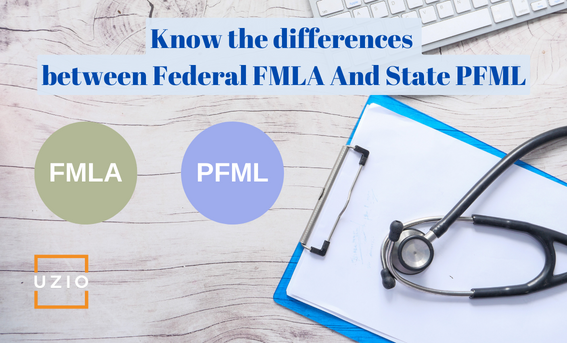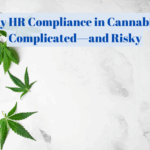
What Is The Difference Between Federal FMLA And State PFML?
Quick links
-
Introduction
-
What is the difference between FMLA and PFML?
-
How is PFML funded?
-
What are Employee Eligibility Requirements?
-
What types of Employers are Covered?
-
What is the Benefit Amount?
-
Common Features across states for PFML
-
State Family Medical Leave Laws
Introduction
You may have heard of the federal law FMLA (Family Medical Leave Act) and laws being enacted by different states called PFML (Paid Family and Medical Leave). You may be wondering what the difference is and if you are in compliance with these laws.
In this article we will explain the difference between FMLA and state PFML laws, and provide you with information specific to your state to help you understand the compliance requirements of these laws.
What is the difference between FMLA and PFML?
What is FMLA?
The Family and Medical Leave Act (FMLA) is a federal law that provides eligible employees with up to 12 weeks of unpaid leave per year to care for a new baby or a sick family member. It is only applicable for companies with 50 or more employees within 75 miles of that location.
What is State Paid Family and Medical Leave (PFML) law?
The State PFML law ensures that the workers continue to get some paid time off if they need to be away from work due to their own illness, illness of their family members or birth of a child.
What is the difference between Federal FMLA and state PFML laws?
The main difference is that the federal law offers unpaid leaves while the state law offers paid leaves. Additionally, federal law does not apply to companies with less than 50 employees. It is important to note that FMLA and PFML must be taken concurrently.
How is PFML funded?
State PFML laws draw funds from state tax payments either from employer or employee or both. The funding structure across states can be classified into three categories:
| Funding Category | States |
|---|---|
| Employee Tax | California, Rhode Island, Connecticut, New York, New Jersey |
| Employer Tax | District of Columbia |
| Employer Tax but with an option to the employer to deduct some portion from employee | Massachusetts, Washington, Colorado, Oregon |
What are Employee Eligibility Requirements?
For FMLA, employees are eligible for leave if they worked for their employer for at least 12 months, at least 1,250 hours over the past 12 months.
For PFML, every state has outlined its own criteria but most of them fall into either of the below categories:
- Should have worked a defined number of hours in the required period.
- Should have earned defined wages in the required period.
- Should have worked for required duration in the required period.
Required period is commonly referred to Base Period and can be calendar year or any fixed period defined in the policy. The state specific eligibility requirements are provided in the table below.
What types of Employers are Covered?
FMLA applies to all public agencies, all public and private elementary and secondary schools, and companies with 50 or more employees.
In the case of PFML, all states mostly cover private sector employees while some states may cover public sector employees as well. Check for state guidelines in the table below if your company belongs to the covered category or not.
What is the Benefit Amount?
FMLA is unpaid leave.
In the case of PFML, states pay a defined percentage of the average weekly wage when an employee takes leave under PFML. The defined percentage varies from state to state and has a maximum weekly limit for the wages to be paid.
Common Features across states for PFML
Some features are nearly common in all state programs which includes:
- Employee eligibility is determined by where the employee works and not where the employee lives
- Job Protection based on certain criteria
- Continuation of health benefits
State Family Medical Leave Laws
| State | Coverage/Eligibility | Family Medical Leave Provisions (paid unless noted) |
Provides Leave to Care for |
|---|---|---|---|
| California (unpaid) |
Private employers with 50 or more employees and all public sector employers. | Up to 12 weeks of unpaid family leave plus four months of maternity disability may be combined for a total of 28 weeks per year. | Child, spouse, parent, domestic partner, child of domestic partner, stepparent, grandparent, grandchild, sibling, or parent-in-law. |
| California (paid) |
Employees who have worked for an employer for at least 12 months, and who have 1250 hours of service during the 12 months prior to the leave. | The California Paid Family Leave insurance program provides up to eight weeks of paid leave to care for a seriously ill child, spouse, parent, or registered domestic partner, or to bond with a new child. The benefit amount is approximately 55% of an employee’s weekly wage, from a minimum of $50 to a maximum of $1067. The program is funded through employee-paid payroll taxes and is administered through the state’s disability program. | Child, spouse, parent or registered domestic partner. |
| Colorado (paid) |
Employers who have employed at least one employee for at least 20 weeks in a year or in the year immediately preceding the year of coverage, or who have paid wages of at least $1,500 in any three-month quarter in the preceding year. Employees that have earned at least $2,500 in covered wages in the base period of the alternative base period. | Up to 12 weeks of paid leave for a personal serious health condition, a family member’s serious health condition, the birth of their child, the placement of a child with them for adoption or foster care, to attend to matters arising from a family member being on active military duty, or for reasons related to domestic violence, sexual assault, stalking, or harassment. | Child, parent, spouse, domestic partner, grandparent, grandchild, sibling, or any individual with whom the employee has a significant personal bond that is like a family relationship. |
| Connecticut (paid) |
Public and private employers with at least one employee. Employees that have earned at least $2,325 in covered wages in the highest-earning quarter of the first four of the most recent five three-month quarters, or if they worked for their employer for at least 12 weeks immediately before the leave is requested. | Up to 12 weeks in two years for the birth or adoption of a child, placement of child for foster care, to care for a family member with a serious medical condition, for the serious medical condition of the employee, to serve as an organ or bone marrow donor, or matters relating to a family member that is an active duty member of the U.S. armed forces. | Child, spouse, parent, civil union partner, parent-in-law or stepparent. |
| D.C. (paid) |
Any public or private employer. Employees who spend more than 50% of their time working in D.C. | Up to twelve weeks to bond with a new child, care for a family member with a serious health condition or care for a personal serious health condition; two weeks to receive prenatal care. | All relatives by blood, legal custody, or marriage, and anyone with whom an employee lives and has a committed relationship. |
| Hawaii (unpaid) | Private employers with 100 or more employees. Excludes public employees. Employees who have worked for six consecutive months. | Up to four weeks per year. Permits intermittent leave for birth or adoption of a child, and to care for a family member with a serious health condition. | Child, spouse, reciprocal beneficiary, parent. |
| Maine (unpaid) | Private employers with 15 or more employees; all state employers, and local governments with 25 or more employees. | Up to 10 weeks in two years for the birth of a child or adoption of a child. Includes leave to be an organ donor. Does not require spouses to share leave. | Child, spouse, parent, sibling who lives with employee, civil union partner, child of civil union partner, or non-dependent adult child. |
| Massachusetts (paid) |
Employers who have earned at least $5,700 (in 2022) or $6,000 (in 2023) over the past 4 calendar quarters. In addition, you must have earned at least 30 times the benefit amount that you are eligible for. | Up to 20 weeks to manage a personal serious health condition, up to 12 weeks to care for a family member or bond with a child, and up to 26 weeks to care for a family member who is a member of the armed forces. | Child, step-children, spouse, domestic partner, domestic partner’s children, spouse or domestic partner’s parents, grandchildren, domestic partner’s grandchildren, grandparents, grandparent’s domestic partner, siblings or step-siblings. |
| Minnesota (unpaid) | All employers with 21 or more employees. An employee who has worked for an employer for at least 12 consecutive months immediately preceding the request, and whose average number of hours per week equal one-half of a full-time equivalent position. All employers with at least one employee for school activities leave only. | Up to 12 weeks for the birth or adoption of a child. Permits employees to use personal sick leave benefits to care for an ill or injured child on the same terms as for the employee’s own use. Up to 10 working days when a person’s parent, child, grandparents, siblings, or spouse who is a member of the United States armed forces, has been injured or killed while in active service. | Child, spouse, parent, grandparent or sibling. |
| New Hampshire (paid) |
The Granite State Family Leave Plan provides paid leave coverage to state employees. Family-leave insurance coverage is also available for purchase by employers with more than 50 employees. Individuals may also purchase family-leave insurance coverage. | Paid leave for a personal serious health condition, to care for a family member’s serious health condition, to care for an infant in the first year after the child’s birth, to be with a child after placement for adoption or foster care, to attend to matters arising from a family member being on active military duty. | |
| New Jersey (Unpaid) |
Employers that are subject to New Jersey’s unemployment insurance law. Agricultural employers are exempt from coverage unless they have at least 10 employees or pay wages of at least $20,000 in a quarter. | Unpaid leave of up to 12 weeks in 12 months or 56 intermittent days to care for a child anytime during the first year after that child’s birth or adoption, or to care for a seriously ill child, spouse, parent or domestic partner. Does not provide leave for the employee’s own serious health condition. | Child, spouse, parent, in-laws or domestic partner. |
| New York (paid) |
All private employers. Employees, full-time or part-time, who have worked 26 or more consecutive weeks for a covered employer. Public employers have the choice to opt in. | Up to 12 weeks per year for birth of a child, placement of a child in adoption or foster care, caring for a family member with a serious health condition, or to assist loved ones when covered parties are deployed abroad on active military service. | Child, spouse, parent, parent-in-law, step-parent, grandparent, grandchild, sibling, domestic partner, or a person with whom the employee has or had an in loco parentis relationship. |
| Oregon (paid) |
Public and private employers with at least one employee. Employees who have earned at least $1,000 in the first four of the last five quarters preceding the benefit year. | Up to 12 weeks per year for a personal serious health condition, a family member’s serious health condition, the birth of a child, the placement of a child for adoption or foster care, or for reasons related to domestic violence, sexual assault, stalking, or harassment. | Child, spouse, parent, grandparent, grandchild or parent-in-law, or a person with whom the employee has or had an in loco parentis relationship. |
| Rhode Island (paid) |
All employers that are subject to Rhode Island’s unemployment insurance law. | The Rhode Island Temporary Caregiver Insurance Program provides up to five weeks of paid leave for the birth, adoption or fostering of a new child or to care for a family member with a serious health condition; and up to 30 weeks of paid leave for a worker’s own disability. | Child, parent, parent-in-law, grandparent, spouse, domestic partner |
| Vermont (unpaid) | All employers with 10 or more employees for leaves associated with a new child or adoption. All employers with 15 or more employees for leaves related to a family member’s or employee’s own serious medical condition. Employees who have worked for an employer for one year for an average of 30 or more hours per week. | Up to 12 weeks in 12 months for parental or family leave. Allows the employee to substitute available sick, vacation, or other paid leave, not to exceed 6 weeks. Does not require spouses to share leave. Provides an additional 24 hours in 12 months to attend to the routine or emergency medical needs of a child, spouse, parent, or parent-in-law or to participate in children’s educational activities. Limits this leave to no more than four hours in any 30-day period. | Child, spouse, parent, parent-in-law. |
| Washington (paid) |
All employers. An employee who has been employed for at least 820 hours during his or her qualifying period. | Up to a total of 12 weeks of leave during any 12-month period for the birth of a child, the placement of a child for adoption or foster care, to care for a family member with a serious health condition, or because of a serious health condition that makes the employee unable to perform the functions of the job. | Child, step-child, spouse, domestic partner, parent, parent-in-law, sibling, grandchildren, grandparents, spouse’s grandparents, son- or daughter-in-law, any individual who expects to rely on the employee for care. |
| Wisconsin (paid) |
Employers who employ at least 50 individuals on a permanent basis, including any state government entity. An employee who has been employed by the same employer for more than 52 consecutive weeks and who has at least 1,000 hours of service during that time. | Up to six weeks of leave for the birth or adoption of a child; up to two weeks of leave care of a child, spouse, parent, domestic partner or parent of a domestic partner with a serious health condition; and up to two weeks of leave for the employee’s own serious health condition. Does not require spouses to share leave. Allows an employee to substitute employer-provided paid or unpaid leave for portions of family or medical leave. | Child, spouse, parent, domestic partner or parent of a domestic partner. |
Sources: NCLS (National Conference of State Legislatures)
Get in touch with us for an expert-led demo to know more about UZIO payroll services.





